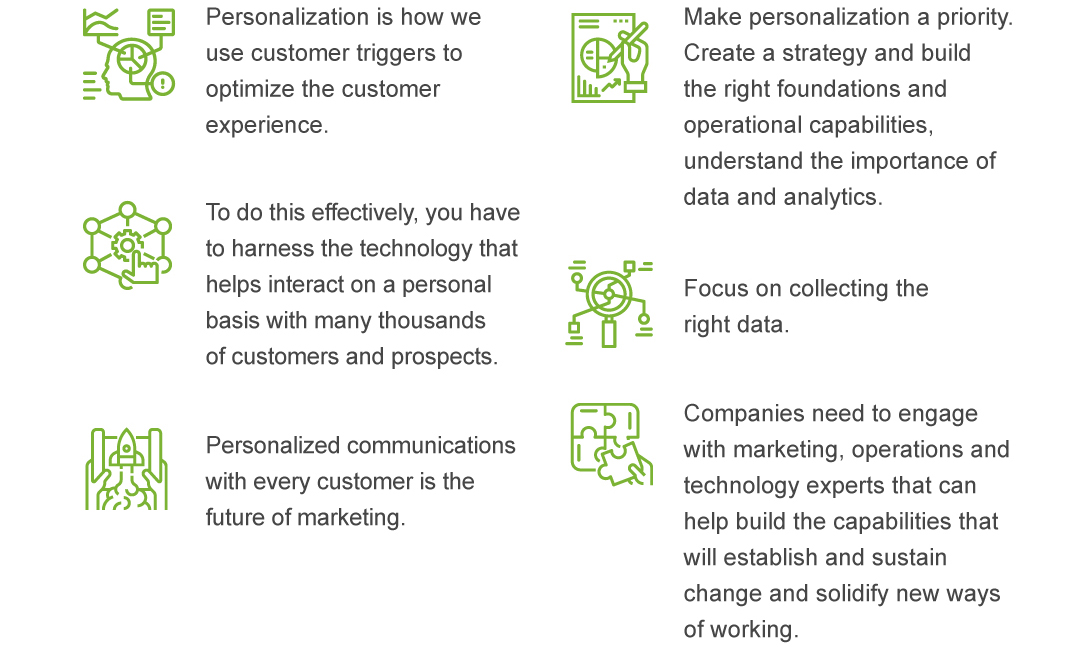Personalization at Scale

Personalization is teetering on the brink of emptiness.
Not because it has no real, tangible value, but rather because it is being touted as the end-all-be-all for everything. As more and more organizations are beginning to embrace the concept of personalization, its actual meaning is being lost in the sea of non-related problems that it is supposed to solve.
At its core, personalization is how we use customer triggers to optimize the customer experience. From a business perspective, personalization allows a company to take all of the information it has on a customer and activate it to deliver those experiences.
In order to do this effectively, you have to harness the technology that enables the business to interact on a personal basis with many thousands of customers and prospects.
Because these are not just a handful of on-to-one conversations, we must reframe the conversation and move it from personalization, to personalization at scale.
The value of personalization has been proven consistently over time but understanding how and when your business should use it can be a challenge, given the level of ambiguity that sometimes surrounds its meaning. This challenge is particularly clear as businesses navigate the complexities required to move from experimenting with personalization to scaling it.
Let’s be clear. Personalized communications with every customer is the future of marketing.
In today’s marketplace, it is not enough to address email recipients by name and send them a coupon or offer based on a past purchase. Today’s modern marketer must deliver tailored messaging and content that is relevant to thousands of customers in multiple interactions.
When done well, personalization can deliver significant growth rather quickly. It also plays a huge role in the full customer lifecycle -- from acquisition and engagement, to order size and frequency, to churn and retention. When fully implemented, creating personalized customer experiences can expose noteworthy near-term value for businesses, such as a 10-30% lift in marketing efficiency, revenue and retention.
So, you may be wondering how to get to personalization at scale. It is not as difficult as it may seem.
First, make personalization a priority. Create a strategy and build the right foundations and operational capabilities. Next, understand the importance of data and analytics. These are the key value generators for personalization, and they have to be the foundation of your thinking. Do not underestimate the value of the data you have. Do not go and try to re-invent the data model. Mine and analyze what is in front of you. Next, decide who your customer is. Using the data we just talked about, understand how your customers behave, what their triggers are and what insights you can act on. Then, capture the low-hanging fruit. What can you do now with little effort?
You’ll also want to avoid some common roadblocks.
Instead of focusing on amassing tons of data, focus on collecting the right data. This is the data that is meaningful for understanding your customers. Instead of putting a lot of effort into seasonal or general events, understand the important triggers for your customers. For example, going to college could be a great time to purchase a new computer, not just because it is Labor Day. Move away from siloed ways of working. Personalization at scale requires agile, cross-functional teams. Finally, resist the temptation to buy the most complicated tools and infrastructure, unless your business requires it. Instead, look for those that will give you a 360 view of the customer, the ability to make decisions based on signals given by the customer, and the ability to distribute coordinated content in real-time. While technology can help move the needle towards personalization, technology itself will not solve the problem.
Companies need to engage with marketing, operations and technology experts that can help build the capabilities that will establish and sustain change and solidify new ways of working. Our experts have the skills, experience and training needed to partner with your organization on your personalization journey. It is not enough for us to be specialists; we are translators who can communicate and help execute the vision comfortably and effectively across all business functions. Are you ready for a partner on your journey to personalization at scale? We’re ready when you are.





